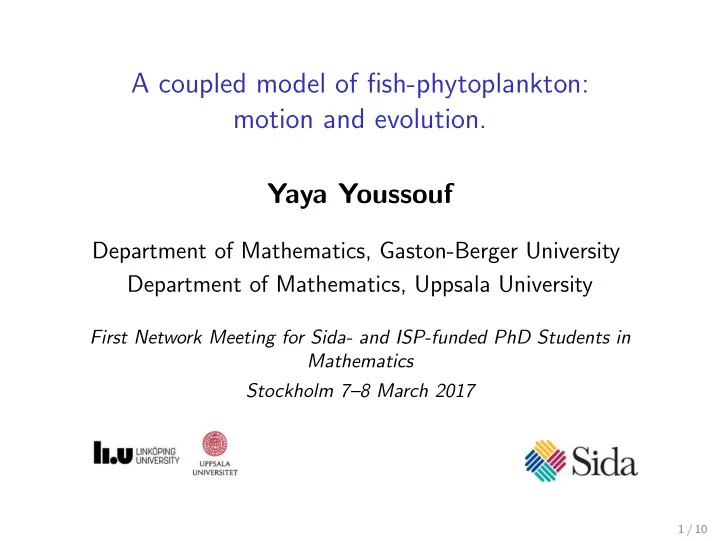

A coupled model of fish-phytoplankton: motion and evolution. Yaya Youssouf Department of Mathematics, Gaston-Berger University Department of Mathematics, Uppsala University First Network Meeting for Sida- and ISP-funded PhD Students in Mathematics Stockholm 7–8 March 2017 1 / 10
My Advisors Pr. Mamadou Sy Pr. David J. T. Sumpter Dr. Maksym Romenskyy Main advisor Assistant advisor Assistant advisor Gaston-Berger University Uppsala University Uppsala University 2 / 10
Research Topic. Interest • Dynamic of populations. 3 / 10
Research Topic. Interest • Dynamic of populations. • Transport-diffusion models. 3 / 10
Research Topic. Interest • Dynamic of populations. • Transport-diffusion models. Problematic • How to construct a like Lotka-Voltera model to describe the dynamic of fish-phytoplankton using a self-proppled particles (SPP) and agent beased model (ABM)? 3 / 10
Research Topic. Interest • Dynamic of populations. • Transport-diffusion models. Problematic • How to construct a like Lotka-Voltera model to describe the dynamic of fish-phytoplankton using a self-proppled particles (SPP) and agent beased model (ABM)? • Which transport-diffusion model should be associated to take in account the motion of population ? 3 / 10
Research Topic. Interest • Dynamic of populations. • Transport-diffusion models. Problematic • How to construct a like Lotka-Voltera model to describe the dynamic of fish-phytoplankton using a self-proppled particles (SPP) and agent beased model (ABM)? • Which transport-diffusion model should be associated to take in account the motion of population ? Goals • Constuction of the model, full anlysis and simulations; 3 / 10
Research Topic. Interest • Dynamic of populations. • Transport-diffusion models. Problematic • How to construct a like Lotka-Voltera model to describe the dynamic of fish-phytoplankton using a self-proppled particles (SPP) and agent beased model (ABM)? • Which transport-diffusion model should be associated to take in account the motion of population ? Goals • Constuction of the model, full anlysis and simulations; • Make a comparaison between Lotka-Voltera model. 3 / 10
General view. SPP Self-propelled particles (SPP), is a concept used by physicists to describe autonomous agents, which convert energy from the environment into directed or persistent motion a . Here are somme examples for autonomous agents: Walking, swimming or flying animals; a Wikipedia 4 / 10
General view. SPP Self-propelled particles (SPP), is a concept used by physicists to describe autonomous agents, which convert energy from the environment into directed or persistent motion a . Here are somme examples for autonomous agents: Walking, swimming or flying animals; Bacteria, phytoplankton, cells, algae and other micro-organisms; a Wikipedia 4 / 10
General view. SPP Self-propelled particles (SPP), is a concept used by physicists to describe autonomous agents, which convert energy from the environment into directed or persistent motion a . Here are somme examples for autonomous agents: Walking, swimming or flying animals; Bacteria, phytoplankton, cells, algae and other micro-organisms; Any system of physical particles with coherent collective behavior for exemple a robot system . a Wikipedia 4 / 10
General view. SPP Self-propelled particles (SPP), is a concept used by physicists to describe autonomous agents, which convert energy from the environment into directed or persistent motion a . Here are somme examples for autonomous agents: Walking, swimming or flying animals; Bacteria, phytoplankton, cells, algae and other micro-organisms; Any system of physical particles with coherent collective behavior for exemple a robot system . a Wikipedia The following pictures illustrates some autonomous agents. 4 / 10
General view. Figure: Spectacular folk of starlings. 5 / 10
General view. Figure: School of Fishs. 5 / 10
General view. Figure: traffic jam in Madagascar. 5 / 10
General view. Figure: A herd of zebra.. 5 / 10
A general SPP model Figure: The two zona in the Vicsek-model. 6 / 10
A general SPP model Figure: The two zona in the Vicsek-model. r i ( t + τ ) = r i ( t ) + τv i ( t ) (1) v i ( t + τ ) = R ( ξ i ( t )) V d i ( t ) (2) 6 / 10
Impact and Applications of My Research Impact Find the basic laws describing the essential aspects of collective motion; 7 / 10
Impact and Applications of My Research Impact Find the basic laws describing the essential aspects of collective motion; Application The applications are a lot and for many discipline: 7 / 10
Impact and Applications of My Research Impact Find the basic laws describing the essential aspects of collective motion; Application The applications are a lot and for many discipline: In mathematics, SPP and ABM gives an alternative for the usual PDEs and ODEs models; 7 / 10
Impact and Applications of My Research Impact Find the basic laws describing the essential aspects of collective motion; Application The applications are a lot and for many discipline: In mathematics, SPP and ABM gives an alternative for the usual PDEs and ODEs models; In physic, SPP and ABM can be used to describe and understand patterns of physicals systems as gases, crystals, liquids ... 7 / 10
Impact and Applications of My Research Impact Find the basic laws describing the essential aspects of collective motion; Application The applications are a lot and for many discipline: In mathematics, SPP and ABM gives an alternative for the usual PDEs and ODEs models; In physic, SPP and ABM can be used to describe and understand patterns of physicals systems as gases, crystals, liquids ... For society, one can solve the problems of crowd panic, trafic jam etc. 7 / 10
Some patterns of fish, phytoplankton and coupled model 800 Fish 700 600 Number of particles 500 400 300 200 100 0 500 1000 1500 2000 Time 900 800 700 600 Phase Map 500 400 300 200 100 200 250 300 350 400 450 500 550 600 650 Fish 8 / 10
Animation of fish-phytoplankton interaction 9 / 10
Thank you! 10 / 10
Recommend
More recommend